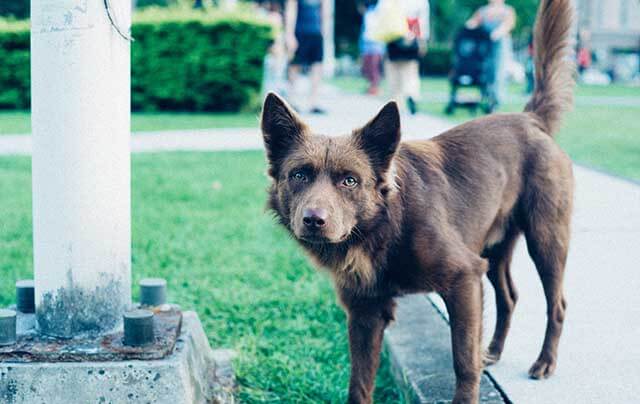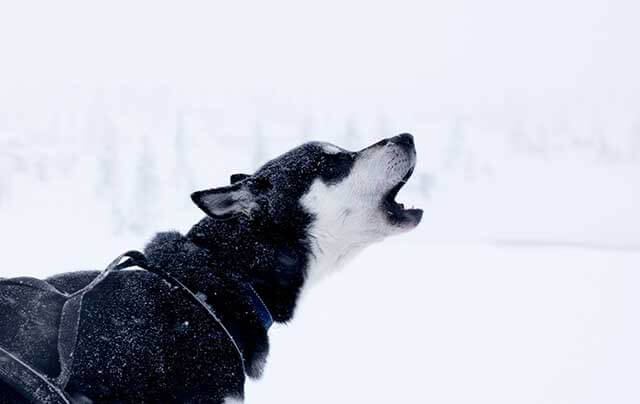Wouldn’t it be great if we could figure out what are dogs re trying to say.
It only takes a bit of training and dogs can understand us quite well… but can we be trained to understand dogs?
If you have a dog and would like to understand what they are saying when they bark, groan or whine, then read on, because you this is on of the most fascinating areas of having a dog.
Barking

The most common noise dogs are associated with is barking. Dogs bark to express different emotions, from happiness to playing to frustration and also affection.
Because a bark can mean many things you have to take into account the situation, pitch and frequency of their bark.
Situation
The wider surrounding are key to understanding why your dog might be barking. If your dog barks then runs to get their favourite toy they’re likely feeling excited. If your dog runs to the front door and growls when someone is approaching they’re likely feeling territorial.
Looking at a dog’s body language can help you decode the bark meaning in a situation.
| Happy Dog Behaviour | Fearful Dog Behaviour |
| Relaxed ears | Growls and barks |
| Tail wagging | Ears pointed forward |
| Excessive blinking | A fixed stare |
Frequency of The Bark
In short the frequency of a bark signals urgency. More dog barks per minute, the more urgent the matter. For example if someone is approaching your door, you might witness your dog barking at a high frequency to signal.. intruder!
Pitch of The Bark
Tone can tell you a lot about the barks meaning. Low pitch barks indicates an aggressive and angry mood. This has been evolutionarily adapted to scare off people. And watching it in action it usually works.
On the flip side a higher pitched bark is usually displayed when a dog is wanting to play or in a state of excitement. However high pitches can be seen when a dog is fearful also.
Dog Whining
The sound of a whine worries us for a reason. These sounds of distress signals are trying to communicate that they are anxious, excited, bored, thirsty or frustrated. Often when your dog is whining at your directly they are trying to request something.
This could be as simple as opening the door for them or an invitation to come and play. Again in many instances looking at the situation they are in is helpful.
Beware of your dog whining reactions
If your dog is whining because they are asking for food at the kitchen table and you agree to the request by giving your dog the food – (even if it’s just leftovers), caution is urged. That’s because you are likely reinforcing this behaviour. If they see success by doing this they will do it more until it’s harder to break the behavioural cycle.
Growling

Growling is associated with aggression. The deep grumbling is usually a signal of this. This is mainly right, but there are times when it’s not the case. The deep grumble is a communication saying step back! These can be caused by anxiety or fear in a situation.
But this is not always the case. Growling can also be playful like in a tug of war, affectionate – heard when cuddling… or frustrated for instance if they are asking for food.
Howling

Howling is a noise that has puzzled dog trainers and researchers for years. There are a couple of theories which indicate howling being common when a dog wants attention, contact with dogs nearby or in the neighbourhood, alert those close by to a discovery.
There is no doubt that howling is a primal behaviour from a dogs predecessor the wolf. It’s usually not a concern. However can be a signal of separation anxiety or sign of injury and pain that should be dealt with via training and veterinary professionals.
Sighs & Groans

Sigh and groans from your dog are very similar to the reasons we humans do it. Signals of frustration, being tired or bored. While one-off groans are to be expected, if your pooch is groaning all too much, there could be a underlying medical disruption they are trying to warn you about.
Adding It All Together
Trying to understand your dog is a lot of fun. Putting together the sounds with behaviours like tail wags and posture can tell you a lot more about your dogs unique needs. Not only that it will help you connect with them at a deeper level so they feel more understood, which translates into happiness!
If you find problems that they are trying to signal make sure to show them to your vet or pet trainer.
But a part from that trying to understand their communication… and communicating back where possible is one of the most enjoyable things you can do with a dog.







Comments